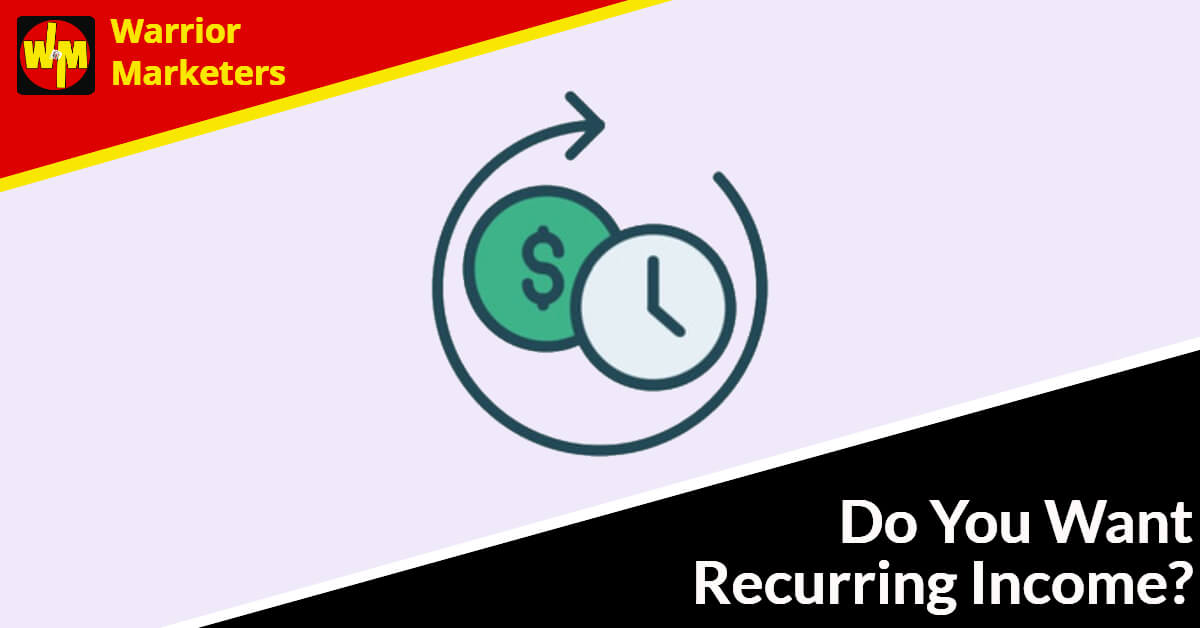Do You Want Recurring Income?

If you’re looking to boost your income, grow a loyal following and position your brand as the go-to source in your market, there is no easier way than by injecting a recurring revenue stream into your business. Trying to build a continuity program into your business is a must.
With recurring revenue, you can create a strong foundation for your business while taking advantage of the opportunity to incorporate additional income streams into an ever-growing community.
Not only will you profit from the regular subscriptions, but you can utilize a series of proven strategies to skyrocket sales of other products and services!
Plus, recurring revenue is consistent and predictable. Unlike other income streams, such as with one-off products or services, with a monthly or yearly recurring revenue platform you know what to expect. You aren’t bouncing from one product launch to another.
Instead, you can focus on growing your community and extending the value of your program. Instead, you are focused on a scalable business and stop trading your time for money.
This article will show you exactly how to join the recurring revenue revolution and how it can work in almost any niche or market.
You’ll also discover how to choose a format that focuses on long-term success so you can enjoy the benefits of passive income every month – all on complete autopilot.
And that’s just one of the many advantages of incorporating a stream of recurring income into your business.
Not only are you able to keep payments rolling in every cycle, but you can set it up so that it works towards driving in customers every single day, all within one platform.
Plus, it’s always easier to sell to existing customers than it is to convert new ones.
Are you ready to begin? Let’s get started!
Recurring Revenue Streams

You’ve seen the rise of recurring revenue streams in your everyday life. Blockbuster fell victim to Netflix; cable TV fell victim to online streaming services like Amazon Prime.
Everywhere you turn, companies are focused on building multi-million dollar businesses on the recurring income platform.
Even brick and mortar businesses have jumped on the bandwagon by creating loyalty programs where people can pay for a certain number of services a month (drink packages, spa treatments, car wash services, express mail delivery services, etc.)
In fact, virtually every business can benefit from adding a recurring revenue stream.
There’s no doubt about it; now is the time to get in on the action.
To start, it’s important to come up with a primary benefit for your recurring income stream.
- Why would people want to sign up for your program?
- What are the benefits?
- How is it different from others?
For example, with a spa package, someone could purchase a $100 package that gives them the ability to book 3 massage treatments, rather than the usual 2.
With an online business, you could offer access to advanced training or exclusive resources not available anywhere else.
The key is to highlight the benefits upfront. Customers sign on for recurring programs because they are getting more bank for their buck, or they are being given access to something unique, special and exclusive.
Or perhaps they are looking to save time or alleviate an otherwise steep learning curve.
In some businesses, the draw is that subscribers belong to a tribe or a community such as with fitness programs or yoga studios, but the same holds true with online programs that incorporate private groups and forums where people can network and encourage one another.
Regardless of the format you choose, you need to come up with a clear benefit that will persuade people to sign on and stay subscribed.
Membership Programs

Subscription-based programs are not only extremely profitable, as they generate recurring income, but they are single-handedly one of the easiest ways to gain traction in your market, and position yourself as an expert in your field.
With a membership program, people sign up for ongoing access to exclusive content. This is where they become part of your community and are often given the option to network with others or ask questions via a private group or forum as they progress through the training.
You’ve likely seen this in action for yourself when you’ve signed up for a course or training program. The course instructor has positioned themselves as an expert on the topic simply by providing a clear, workable system to accomplishing a specific goal or task.
By providing step-by-step training in a specific niche, you will be able to secure your foothold in your market and become a leading source for quality information.
In other words, you become the go-to person in your field. They are phenomenal at increasing your customer outreach, maximizing exposure and managing a sales funnel so that you can leverage your ever-growing community.
Another great thing about the membership model is that you can create a flagship program that is geared towards helping your subscribers learn about one topic, and then work towards expanding your program as your community grows so that you are keeping subscribers moving through your sales funnel.
There are many ways to build a successful membership program. Begin by considering the commonly asked questions in your niche. Perhaps someone needs help with graphic design. Rather than spending all your time teaching people how to master a specific software program on a one-on-one basis, you could create a membership site that offers access to video training that shows them how to use a third-party product to enhance their business.
Then, not only are you generating recurring income from your own training program, but you are also able to make money via affiliate marketing.
You can package your membership program in many ways including by offering tutorials, resources, coaching, community access, or a combination of them all.
There are a few popular models used to create membership websites, including:
Evergreen Content Model
This is where your content is released in the same sequence regardless of when someone joins your program.
For example, someone who joins in January would receive access to the first month’s content immediately, and then in February they would receive access to the second month’s content and so on.
A member who joins in February would still receive January’s content as month 1. Every member starts at the beginning of your content cycle and then progresses as the month’s go on.
With an evergreen content system, the content is released sequentially based on each customer’s join date.
These are often the easiest membership sites to set up because you can create the content once, and then set & forget.
The only downside to this format is that you may struggle to offer group coaching as students will be at different stages of your training.
Current Month Access
This type of membership platform is based on the current month. Someone signing up in January would receive access to that current month’s content.
If someone signed on in February, they would only gain access to that current month’s content. So, every member is given access only to the latest update.
You can further monetize this style of membership site by giving members the option to purchase access to archived content separately.
This model helps to increase the value of every customer because they are purchasing access to current content while being able to purchase additional access to unlock prior months or advanced content. This format works well if your content is segmented so that each month’s content can stand alone and isn’t dependent on previous lessons or training.
All Access Pass (Content Buffet)
This format usually involves providing members with access to all previous content as well as new content on a monthly basis as long as they are a paid member.
Typically, you can price these membership programs at a higher price point because subscribers are gaining access to all the available content, regardless of when it was released.
Programs that run this way would include programs like https://www.Lynda.com where you pay for access to their training database and can then browse through their full library of courses and training material that continues to grow.
Consider the different formats available so you can determine what would work best for your target market.
For example, the weight loss market is a popular one for membership programs (example: Weight Watchers), because their monthly program guides someone through their journey from the very beginning until they’ve reached their weight loss goals.
Their monthly membership never ends either because even when someone finally reaches their goal weight, they are then transferred into a membership program designed to help them maintain their weight.
And another valuable part of their community is in the groups and forums members gain access to. In these areas, they can find an accountability partner, personal online trainers and coaches that help them stay on track.
With this type of platform, you are not only able to generate income monthly from the recurring membership fees, but you could easily expand your membership program to offer additional upgrades, such as access to weekly meal plans, community support, fitness strategies and customized weight loss plans.
Regardless of the membership format you choose, you’ll want to make sure you use a platform that supports your goals.
You should look for a membership software solution that offers quick-set up, a user-friendly admin panel, security and of course, flexibility regarding content options as well as payment processors.
I personally recommend ProductDyno, available at:
ProductDyno.com
ProductDyno works for all digital product formats, including the ability to sell monthly content in whatever format you choose, as well as the ability to sell licenses to software, themes, designs or plugins.
The admin panel is intuitive, and they offer prompt support and regular updates so you can rest assured you’re given access to in-demand features. It’s simply one of the easiest ways to get your membership site off the ground with minimal cost and effort.
Bonus Tip: Once you have your membership program off the ground, you could offer personalized coaching access to a small group of students. You could choose to offer this only once a year when you have time or offer it on an ongoing basis.
Coaching is a premium service which means that you’ll be able to set a higher price point than other types of services. It’s a great way to inject additional cash flow into your existing community.
Courses are a great product to put into your membership platform and if you want to know more about creating a profitable online course, check out the featured resource below for a free report; download, read it and take action 😊





























